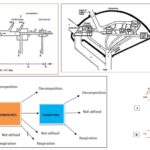Diffusion of gases occurs in the alveolar region only and not in the other parts of respiratory system. Why?
Diffusion of gases occurs in the alveolar region only and not in the other parts of respiratory system. Why?
Please login to submit an answer.
Gas diffusion occurs only in the alveolar (respiratory) zone—not in conducting airways—because alveoli provide the necessary structural and physiological conditions for efficient gas exchange.
Alveoli offer extremely large surface area—estimates range from 70–145 m²—due to their millions of tiny sacs and extensive branching network of respiratory bronchioles, ducts, and sacs. This maximizes gas contact with blood.
The alveolar–capillary barrier is exceptionally thin (≈0.2–2 µm), comprised of a single-layered squamous epithelium and capillary endothelium, minimizing diffusion distance.
Alveoli are richly vascularized; dense capillary networks surround each alveolus, maintaining steep partial pressure gradients for O₂ and CO₂.
The alveolar surface is moist and contains surfactant, which facilitates gas solubility and prevents alveolar collapse, supporting rapid diffusion.
In contrast, conducting airways (nose, trachea, bronchi, bronchioles) lack these features: they have thick, multilayered walls, far fewer capillaries, no surfactant, and are designed only for air passage and conditioning. Hence they serve as anatomical dead space without appreciable gas exchange.
According to Fick’s law, diffusion efficiency relies on large surface, thin barrier, short distance, and pressure gradients—all optimized in alveoli but not in other airway regions.
Consequently, alveolar structures uniquely support the high-volume, high-speed gas transfer needed for life, which cannot occur efficiently in other parts of the respiratory tract.
- Share on Facebook
- Share on Twitter
- Share on LinkedIn
Helpful: 0%




